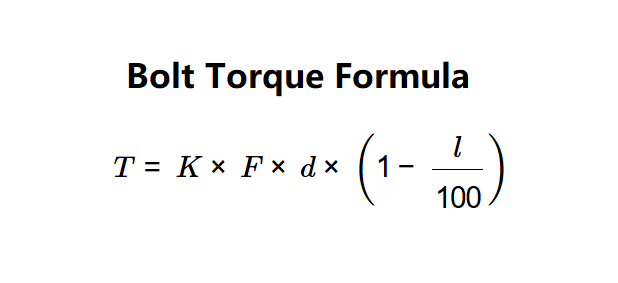1. What is the Bolt Torque Calculator?
Definition: This calculator estimates the torque required to achieve a specific clamping force for a bolt, based on the bolt’s material, diameter, lubrication, and a constant factor \( K \).
Purpose: It assists engineers, mechanics, and DIY enthusiasts in determining the appropriate torque to apply when tightening bolts, ensuring secure fastening without over-tightening or damaging components.
2. How Does the Calculator Work?
The calculator uses the following equation:
- \[ T = K \times F \times d \times \left(1 - \frac{l}{100}\right) \]
Where:
- \( T \): Torque (N·m, kgf·cm, J/rad, lbf·ft, or lbf·in);
- \( K \): Constant factor based on bolt material and finish (e.g., 0.2 for mild-steel, dry);
- \( F \): Clamping force (N or lbf);
- \( d \): Bolt diameter (mm, cm, m, in, or ft);
- \( l \): Lubrication percentage (%).
Steps:
- Enter the clamping force and select its unit (N or lbf).
- Enter the bolt diameter and select its unit (mm, cm, m, in, or ft).
- Select a lubricant (e.g., Graphite) or choose custom and enter a lubrication percentage (0-100).
- Select a bolt type (e.g., mild-steel, dry) or choose custom and enter a \( K \) factor.
- Convert inputs to metric units (N for force, m for diameter).
- Calculate torque in N·m using the formula.
- Convert torque to the selected output unit (N·m, kgf·cm, J/rad, lbf·ft, or lbf·in).
- Display the result, formatted in scientific notation if the absolute value is less than 0.001, otherwise with 4 decimal places.
3. Importance of Bolt Torque Calculation
Calculating the correct bolt torque is crucial for:
- Safety: Ensures bolts are tightened to hold components securely without failure.
- Durability: Prevents over-tightening, which can damage bolts or threads, or under-tightening, which can cause loosening.
- Precision: Accounts for material, lubrication, and size to achieve the desired clamping force.
- Efficiency: Optimizes assembly processes in engineering and construction.
4. Using the Calculator
Example 1 (Metric Units): Calculate the torque with metric units and Graphite lubricant:
- Clamping Force: \( F = 10000 \, \text{N} \);
- Bolt Diameter: \( d = 12 \, \text{mm} \);
- Lubricant: Graphite (\( l = 52.5\% \));
- Bolt Type: Mild-steel, lubricated (\( K = 0.18 \));
- Output Unit: Newton meters;
- Torque: \( T = 0.18 \times 10000 \times 0.012 \times (1 - 0.525) = 10.26 \, \text{N·m} \);
- Result: \( T = 10.2600 \, \text{N·m} \).
Example 2 (Imperial Units, Custom Lubrication): Calculate the torque with imperial units and custom lubrication:
- Clamping Force: \( F = 2000 \, \text{lbf} \);
- Bolt Diameter: \( d = 0.5 \, \text{in} \);
- Lubricant: Custom (\( l = 30\% \));
- Bolt Type: Custom (\( K = 0.25 \));
- Output Unit: Pound-force inches;
- Force: \( 2000 \times 4.44822 = 8896.44 \, \text{N} \);
- Diameter: \( 0.5 \times 0.0254 = 0.0127 \, \text{m} \);
- Torque: \( 0.25 \times 8896.44 \times 0.0127 \times (1 - 0.3) \approx 19.7697 \, \text{N·m} \times 8.85075 \approx 175.0047 \, \text{lbf·in} \);
- Result: \( T = 175.0047 \, \text{lbf·in} \).
5. Frequently Asked Questions (FAQ)
Q: Why does the K factor vary?
A: The \( K \) factor depends on the bolt’s material and surface finish (e.g., dry, lubricated, or plated), affecting friction during tightening. Common values range from 0.1 to 0.3.
Q: How do lubricants affect torque?
A: Lubricants like Graphite or SAE oils reduce friction, lowering the torque needed. Predefined percentages (e.g., 52.5% for Graphite) reflect typical friction reduction; custom values allow flexibility.
Q: Can I use this for non-mild-steel bolts?
A: Yes, select the custom option and enter the appropriate \( K \) factor for your bolt material (e.g., stainless steel may have \( K \approx 0.2 \)).
 Home
Home
 Back
Back
